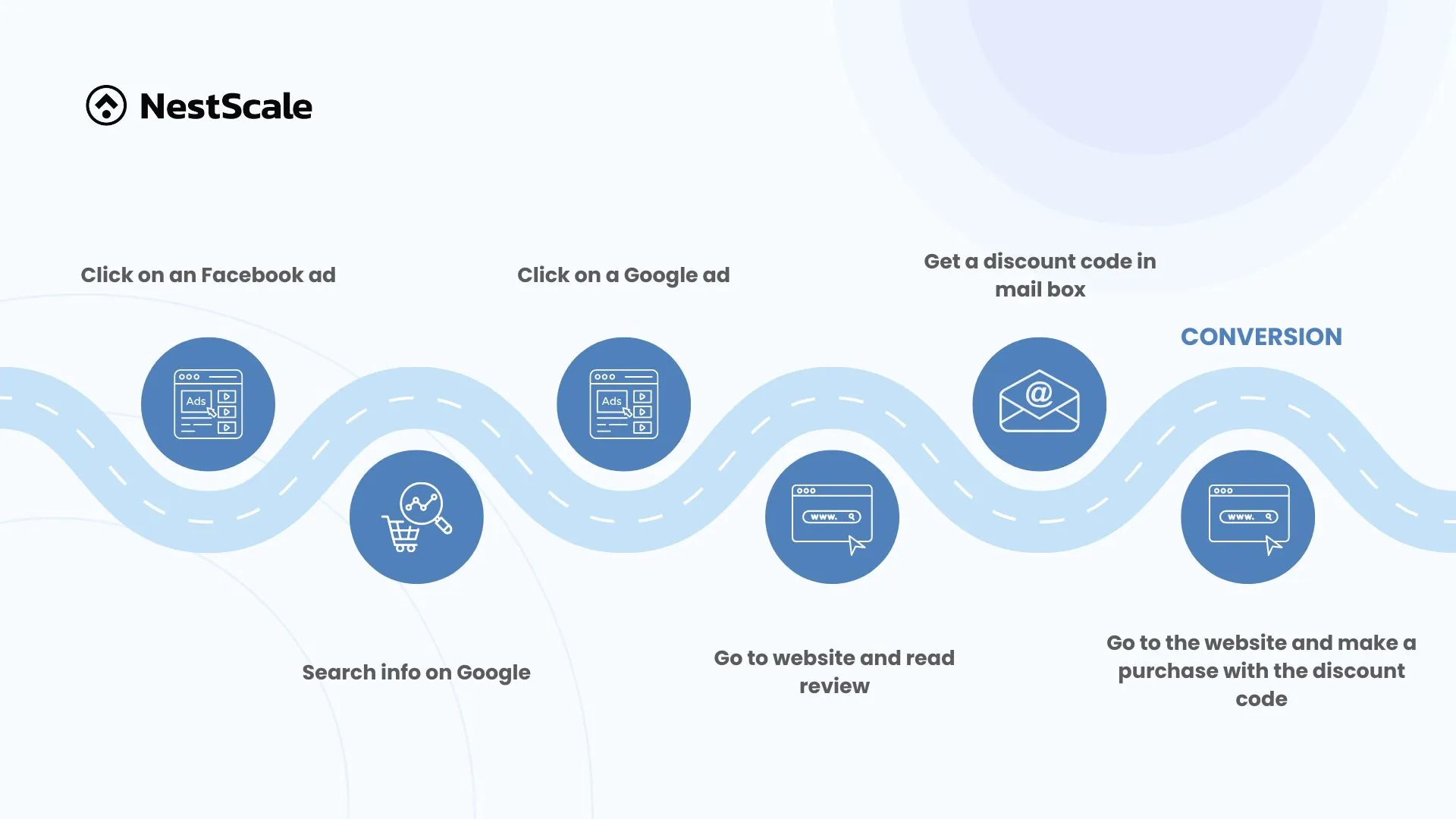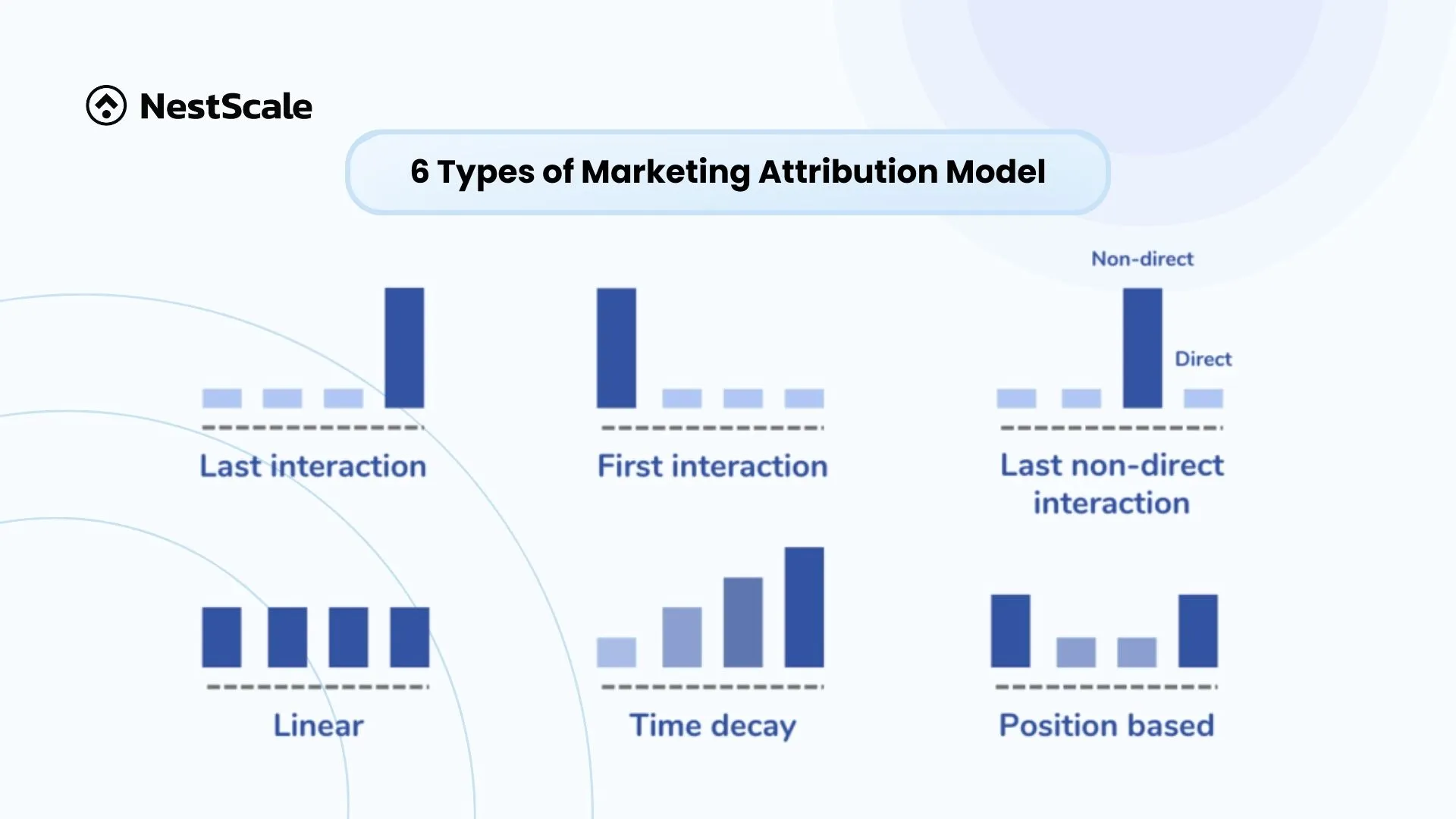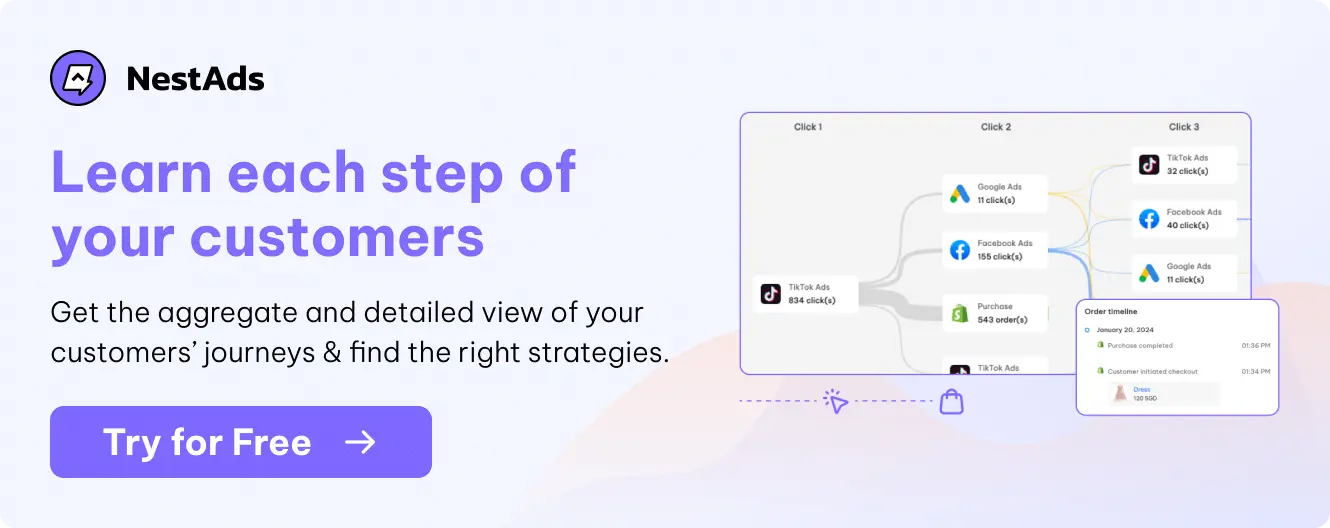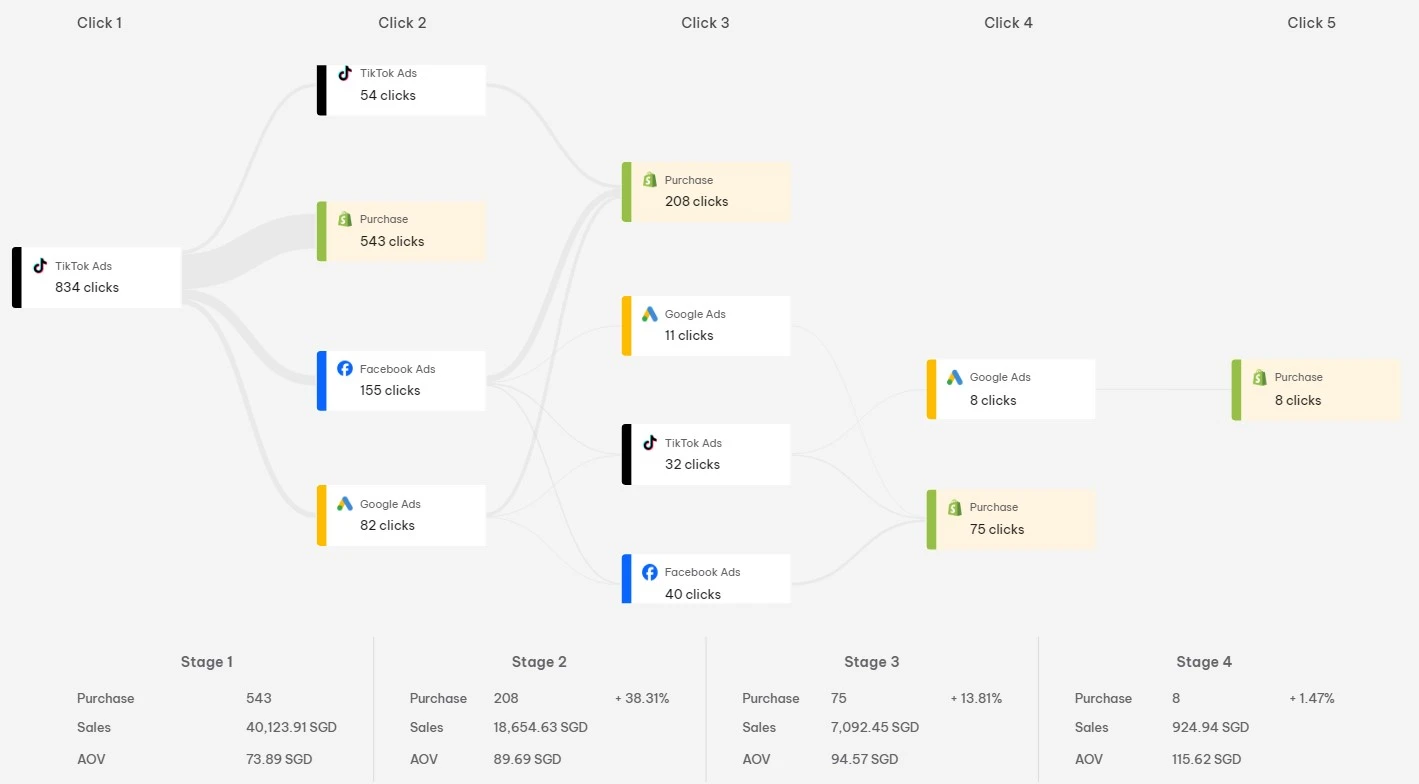The path from a customer’s first interaction to their final purchase is no longer straightforward. It’s a complex journey that spans multiple channels and touchpoints. Hence, almost all brands are leaning towards omnichannel and personalization marketing to better engage customers. So now the question is, is simply tracking conversions good enough? We don’t think so.
Today, we aim to create a smooth customer experience at every touchpoint and build long-term relationships with them. This also aligns with the big goal to enhance customer lifetime value and encourage brand loyalty, which is essential for every brand. With all these factors in mind, customer journey attribution has become a powerful strategy for businesses to grow sustainably in the current competitive eCommerce landscape.
Understanding customer journey attribution
Simply put, customer journey attribution is the process of identifying and crediting the different touchpoints a customer interacts with on their way to making a purchase.
How is a customer journey formed?
A customer journey is formed through a series of interactions, or touchpoints, that connect a potential customer with a brand. And customer journeys are diverse as they’re uniquely shaped by the specific touchpoints each customer encounters.
Whether through social media ads, website visits, emails, or online searches, each interaction plays a great part in guiding a customer toward a decision. Mapping these touchpoints helps you visualize a customer’s path and gain insights into how they engage at different stages.
Let’s imagine Sarah, a potential customer, who is interested in buying a new pair of running shoes. Her journey could look like this:

- Awareness stage: Sarah is scrolling through Facebook when she sees an ad from a well-known shoe brand showcasing a new line of running shoes. She clicks on the ad, but doesn’t purchase anything. This is her first exposure to the brand.
- Consideration stage: A few days later, Sarah searches on Google for “best running shoes for women.” She comes across a paid Google ad from the same shoe brand, clicks on it, and is taken to their website. She browses the options, reads reviews, and compares different styles, but still doesn’t make a purchase. She’s gathering information to make a decision.
- Decision stage: A few more days pass, and Sarah receives an email from the brand offering a 15% discount on her next purchase. She clicks on the email and revisits the website. This time, she decides to buy a pair of shoes she liked during her earlier visit. She applies the discount and completes the purchase.
As you can see from the purchasing journey of Sarah, a customer goes through different stages before finally making a purchase. This is where attribution comes into play in the customer journey to help you understand which of these interactions, or touchpoints played the most significant role in driving the purchase. Thereby, you can allocate resources more effectively to enhance customer experience and optimize for conversions.
How to attribute each touchpoint in the customer journey?
To quantify the effectiveness of each touchpoint in the customer journey, we have 6 major types of marketing attribution models. Each model offers a different way to view your customer interactions, so the decision on what to choose is based on various factors.

- First-Touch Attribution: Gives all credit to the first interaction.
- Last-Touch Attribution: Assigns all credit to the last interaction before purchase.
- Linear Attribution: Distributes credit equally across all touchpoints in the journey.
- Time Decay Attribution: Gives more credit to interactions closer to the conversion.
- Position-Based (U-Shaped) Attribution: Emphasizes both the first and last interactions, with less weight to middle touchpoints.
- Data-Driven Attribution: Uses algorithms to allocate credit based on actual data, adapting to each journey’s unique impact.
- Multi-touch Attribution: Provides a more comprehensive view of the customer journey by giving credit to multiple touchpoints.
How can attribution enhance your customer journey optimization?
Attribution makes everything seem clearer for businesses to make better decisions in marketing. Every touchpoint in the customer journey has its own role in shaping a purchasing decision. Therefore, through attribution, you can identify which touchpoints resonate most with your customers at each stage of the journey.
When these insights inform decisions, you can meet customers with relevant messages and offers that increase engagement and make the path to purchase smoother and more satisfying. Besides, what most businesses worry about, is how to allocate the marketing spend properly for each channel. This is no longer a guesswork, and you can totally based on the attribution data to invest where you can obtain the greatest results.
Attribution also enables you to build a continuous feedback loop. This means you’ll analyze customer journeys, adapt strategies, and improve the experience further. What we think attribution did great is how it transformed the viewpoint of brands to see the customer journey as a series of impactful interactions.
This helps you foster a journey that feels more intuitive and aligned well with shopper expectations. Thereby, each interaction feels purposeful, meaningful, and close to the buying intent. This is the key to engaging and retaining your customers.

How to apply customer journey attribution?
Basically, here are essential steps to apply customer journey attribution:
- Collect customer data
- Map out your customer journey
- Modeling customer journey with attribution
Let’s take a deep dive into each step.
Collect customer data
To get a clear picture of your customer journey, you should gather data from a variety of sources. Here are a few types of data you may need:
- Real-time interaction data: Tracks live interactions customers have on your website, app, or chat, to see exactly how they engage.
- Marketing and Sales campaign data: Measures customer response to different campaigns and helps you understand which channels are performing.
- Product data: Records information on what products or services customers show interest in or purchase.
- Customer support data: Reveals patterns in the questions customers ask or issues they face, which can help improve journey touchpoints.
- Mobile data: Tracks customer interactions on mobile devices, showing their mobile experience and engagement patterns.
- Behavior analysis and web browsing data: Observe behaviors such as page views, clicks, and browsing habits on your site.
- Survey and marketing automation data: Captures customer preferences, feedback, and interests directly from forms, surveys, or email marketing.
*Pro tip: You should make use of first-party data, which customers provide directly through interactions with your brand, which is more accurate and reliable than third-party data. For example, user profiles created through sign-ups or purchases, website and app tracking, feedback channels, etc.
Map out your customer journey
1. Define the stages of your customer journey
Start by tracking your customer journey from first hearing about your brand to finally making a purchase.
2. Identify your key channels
Ask yourself which marketing channels are being used at each stage. Consider channels such as social media, email campaigns, or paid ads. Mapping channels into stages will help you see where you’re reaching customers along the journey.
3. Evaluate engagement and spending on each channel
Once you’ve mapped channels, look at each channel’s engagement and spend:
- Engagement: Which channels receive the most clicks, likes, shares, or responses?
- Budget: Where are you investing most of your marketing budget?
This comparison lets you see if you’re allocating resources effectively and where customers interact with your brand the most.
4. Measure journey duration
Determine the average time it takes for prospects to move through each stage. Do they stay in the consideration stage for weeks or only days? This helps set realistic expectations and refine your strategies.
Modeling customer journey with attribution
In this stage, there are 2 options for you to consider, which are manually creating a visual map or using attribution software.
For the first option, you can represent the journey with:
- Flow charts: Show each stage with touchpoints leading customers forward.
- Funnel diagrams: Display customer volume at each stage to reveal drop-offs.
- Path diagrams: Map out the sequence of touchpoints customers take before buying.
There are several tools that can help you to map it effectively such as Google Analytics, Tableau, or Excel. Once your journey is mapped and visualized, look for these patterns to obtain insights:
- Which touchpoints attract the most attention at each stage?
- Where do customers drop off or move forward?
- Are certain channels or stages more impactful than others?
*Note: This method requires quite a lot of time and resources because it demands a high level of accuracy.
So if you’re not familiar with this, we recommend falling back on attribution software to improve your efficiency. You can try this in NestAds, we think the simple interface and its journey-based attribution function are suitable for most eCommerce businesses, especially when you started from scratch with attribution.
NestAds allows you to integrate your Shopify store and all ad accounts into the platform. Afterward, you’ll get a clear visual aggregated and detailed customer journey empowered by attribution as illustrated in the image below.

For more details, we have this short video that may be helpful for you to get a clearer picture of this feature:
Best practices to approach customer journey attribution
As the digital marketing landscape evolves, tracking and understanding each user’s unique journey is becoming more challenging. So there are a few things you should notice to implement customer journey attribution more effectively.
Pay attention to view-through attribution
View-through attribution gives credit to a marketing touchpoint (such as an ad) when a user views it but does not immediately click on it. If the user later visits the website and converts (e.g., makes a purchase, or fills out a form), the view of that ad is credited for helping drive the conversion, even if there was no direct click.
This type of attribution is important to understand the effectiveness of display ads and other visual marketing efforts. In many cases, customers are exposed to ads multiple times before they make a purchase or take an action, and view-through attribution helps track the impact of these exposures.
Therefore, it’s essential to complement view-through attribution with other models when implementing customer journey attribution. You will see the big picture of how customers move through the full journey, especially for campaigns focused on awareness and consideration.
Look at the big business picture
Attribution did a good job of making sure each dollar is spent effectively on impactful touchpoints. However, to validate these investments at a strategic level to see the cumulative value of all marketing efforts to revenue and growth, you need to pay attention to marketing contribution as well.
Marketing contribution helps you assess the overall impact of each marketing channel, campaign, or tactic on business revenue. Here, you’re looking at the bigger picture: how much revenue or conversions each channel brings, independent of the exact customer journey details.
So here are 3 practices to gain better insights for your business from both attribution and contribution:
- Use contribution data to validate attribution insights to avoid overspending on campaigns that have high interactions but make no difference in business revenue.
- Set specific KPIs that track engagement metrics for individual touchpoints as well as overall revenue contributions for each channel.
- Use incremental testing to confirm the true value of each ad campaign or channel.
Value your customer privacy
Customer journey attribution involves tracking and analyzing data on the steps a user takes before converting. However, this data can be sensitive, as it may reveal personal browsing habits, preferences, and other behaviors. So it’s crucial for any business to apply a privacy-focused approach when collecting data:
- Be transparent: Clearly explain how and why you’re collecting data, and make privacy notices easy to understand.
- Get consent: Make sure users explicitly agree to data collection and understand what they’re consenting to.
- Limit data: Only collect the data you truly need for attribution, avoid gathering unnecessary details.
- Stay compliant: Regularly check your data practices to ensure they align with current privacy laws.
Final thoughts
Customer journey attribution is constantly evolving, and today’s digital landscape shows us how valuable it is to use advanced models and multi-channel strategies to get a clearer picture of what works. So it may feel complex, but you can make a difference when you actually know how to harness its potential. When you commit to learning and adapting over time, your brand can truly make the most of attribution and unlock new levels of growth.




















































